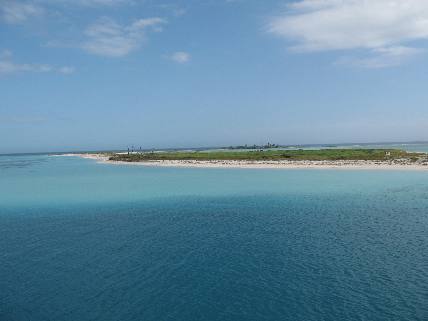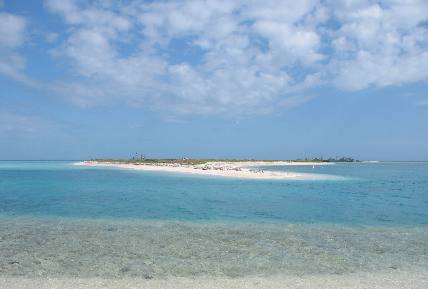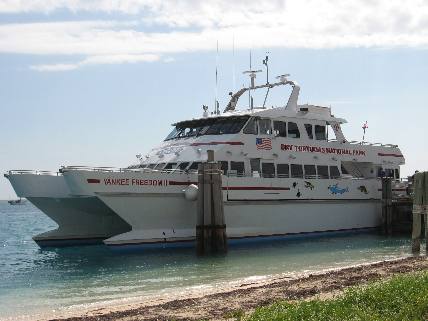Islands of Dry TortugasGarden Key 2nd largest Island in the Dry Tortugas
The Dry Tortugas are a small grouping of islands, located about 70 miles west of Key West, Florida. The Dry Tortugas are small islands. The 2nd largest is Garden Island, where Ft Jefferson is located, and Garden Island is only around 16-acres. The island you see in this picture is Garden Island where Ft Jefferson is located. Island in the Dry Tortugas
Brush Key is the third largest island in the Dry Tortugas chain. Back in the 1800's it was called Hog Island when pigs were raised on the island to feed prisoners at Fort Jefferson. The Dry Tortugas were named because of their distinctive characteristics. First they are Dry, because none of the islands has fresh water. And early seafaring maps had that note on them ---- they were DRY. And Tortugas, because early Spanish explorers, saw an abundance of sea turtles (Tortugas) on the islands. Those sea turtles were like manna from heaven for early seafarers who would catch the large turtles then store them on their backs in the holds of sailing ships and butcher them when they wanted fresh meat. Ft Jefferson in the Dry Tortugas
Garden Key, with Fort Jefferson and the inactive Garden Key lighthouse is the second largest island in the Dry Tortugas. Fort Jefferson was built to protect one of the most strategic deepwater anchorages in North America especially in the 1800's. Fort Jefferson was constructed to hold the Tortugas anchorage against strong naval attack. Bear in mind that in the mid-1800's the Dry Tortugas were in a very strategic location. By fortifying this spacious harbor, the United States could maintain an important “advance post” for ships patrolling the Gulf of Mexico and the Straits of Florida. Keep in mind that during the mid-1800's commerce was flowing from the interior of our country down the Mississippi River and a dozen other rivers that connected the interior of our country to markets accessible via the Gulf of Mexico. Take out a map and look at the location of Fort Jefferson in the Dry Tortugas 70-miles west of Key West. The islands and shoals that make up the Dry Tortugas are navigation hazards that has been the graveyard for hundreds if not thousands of ships. However, the harbor offered ships a chance to resupply, refit, and seek refuge from storms. Whoever controlled the Dry Tortugas also controlled shipping in the Gulf of Mexico. As you can see the location of the Tortugas, along one the world’s busiest shipping lanes, was its greatest military asset. Though passing ships could easily avoid Fort Jefferson’s guns, they could not avoid the warships that used the harbor Fort Jefferson controlled. So it was the "HARBOR" and anchorage at the Dry Tortugas that Fort Jefferson was build to protect. Dry Tortugas Lighthouse on Loggerhead Key
This is Loggerhead Key, with the Dry Tortugas lighthouse. It is the largest island in the Dry Tortugas and is located a few miles west of Garden Key and Ft Jefferson.
Dry Tortugas Lighthouse on Loggerhead Key
Loggerhead Key, with Dry Tortugas lighthouse. Loggerhead is the name of a large sea turtle that nests in the Dry Tortugas. Joyce took this picture from Ft Jefferson on Garden Key.
Loggerhead Key and Dry Tortugas Lighthouse as seen from Ft Jefferson
That is Loggerhead Key, with Dry Tortugas lighthouse as seen from Ft Jefferson. Loggerhead Key is the largest island in the Dry Tortugas and it has the highest elevation at 10 feet.
Bush Key or Hog Island in the Dry Tortugas
The islands of the Dry Tortugas are low and irregular. Some have thin growths of mangroves and various other vegetation, while others have only small patches of grass or are devoid of plant life. The Dry Tortugas rise from relatively deep water. That is Brush Key as seen from Garden Key and Ft Jefferson.
Bush Key or Hog Island in the Dry Tortugas
As you can see this small island (Bush Key) has sparse vegetation. Bush Key was called Hog Island in the 1800's because of the hogs that were raised there to provide fresh meat for the prisoners at Fort Jefferson. It is just a stones throw away from Garden Key. Bush Key is the third largest island in the Dry Tortugas. From April to September each year Sooty Terns and Brown Noddys use the island for nesting and raising young. Keep in mind that the islands of the Dry Tortugas continually change size and shape. Smaller islands, which can be nothing more than sand bars, disappear and reappear as a result of storms and current patterns.
Yankee Freedom II is the ferry to Garden Key and Fort Jefferson in Dry Tortugas National Park
Since Garden Key and Fort Jefferson are located in the Dry Tortugas 70-miles west of Key West the only way to get here is by boat or sea plane. We opted for the "boat" option and took the Yankee Freedom II ferry from Key West to Fort Jefferson in the Dry Tortugas. The 70-mile ride each way on the Yankee Freedom II is a special treat itself. It takes you past other islands in the Florida Keys chain of islands. However, these islands are not connected to the mainland by bridge. Once you leave Key West Harbor on the Yankee Freedom II you are heading into an area only accessible by boat or sea plane. Thirty miles from Key West the Yankee Freedom II takes you past the Marquesas Keys and thousands of lobster trap buoys and the boats working these lobster traps. The Yankee Freedom II is the ferry service that transports visitors to Dry Tortugas National Park every day. Click here for more Key West travellogsUntil next time remember how good life is. More Florida AdventuresMore Key West Adventures ** More 2011 Travel Adventures
Mike & Joyce Hendrix
Mike & Joyce Hendrix who we are We hope you liked this page. If you do you might be interested in some of our other Travel Adventures: Mike & Joyce Hendrix's home page Travel Adventures by Year ** Travel Adventures by State ** Plants ** Marine-Boats ** Geology ** Exciting Drives ** Cute Signs ** RV Subjects ** Miscellaneous Subjects
We would love to hear from you......just put "info" in the place of "FAKE" in this address: FAKE@travellogs.us Until next time remember how good life is. |
| ||
|
| |||
|
| |||
|
|


